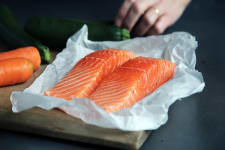
How to Pan-Fry Pacific Halibut Cheeks
March 14th, 2025The Best Way to Sear This Delicate Cut of Pacific Halibut
Pan-frying is quick and elegant way to serve Pacific halibut cheeks. This special cut of fish cooks quickly and can be a bit delicate to handle, so a dusting of flour (all-purpose or gluten-free) helps prevent the fish from sticking to the pan, and also makes it much easier to flip the cheeks. Alternatively, Pacific halibut cheeks are a great cut of fish to coat in a crispy breading, as in this recipe for Pacific Halibut Cheek Katsu.
Simple Tips for Perfectly Pan-Fried Pacific Halibut Cheeks
-
Pat the cheeks to remove excess moisture.
-
Sufficiently heat your pan and oil (sizzling hot!) before adding the fish.
-
Use a dusting of flour or breading to prevent sticking.
How to Pan-Fry Pacific Halibut Cheeks
By Wild Alaskan Company
Prep time
5 minutes
Cook Time
10 minutes
Total time
15 minutes
Yield
2 servings
Ingredients
- 1 (12 oz.) pack of Pacific Halibut Cheeks
- High-heat cooking oil
- Salt and freshly ground black pepper
- Flour (all-purpose or gluten-free)
Instructions
1. Heat a large skillet over medium-high heat. When skillet is hot, add just enough oil to cover bottom of the skillet.
2. Meanwhile, use a tea towel or paper towel to pat fish dry, then lightly season both sides with salt and pepper. Dust with a fine layer of flour.
3. Once oil has begun to shimmer, carefully add halibut cheeks to the skillet and sear each side, flipping halfway through cooking. Use a fish spatula to help you flip the cheeks. Smaller pieces will only need a minute per side, while palm-sized pieces will need 2 minutes. Halibut is medium-done when it registers 120F at the thickest part of the cheek with an instant-read thermometer, or when cheek is slightly firm to the touch. Transfer cheeks to a serving platter and enjoy immediately.
Consuming raw or undercooked meats, poultry, seafood, shellfish, or eggs may increase your risk of food-borne illness, especially if you have a certain medical condition. The FDA recommends an internal temperature of 145°F for cooked fish.





